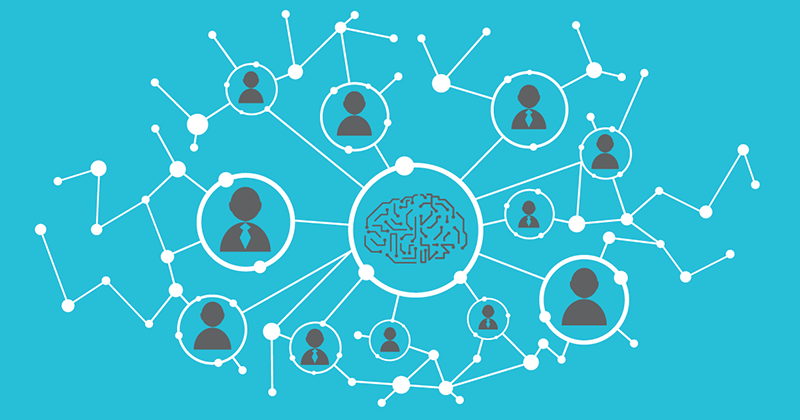
Introduction
The wave of automation is taking root in talent acquisition. Talent acquisition is reaping the benefits of intelligent automation (IA) and using it to transform sourcing, recruiting, and onboarding processes. This article will introduce the concept of cognitive recruiting and cover the benefits and considerations of implementing these capabilities within your talent acquisition organization.
 Cognitive recruiting is, to put it simply, the deployment of intelligent automation across the end-to-end recruiting process. Intelligent automation can include, but is not limited to, robotic process automation, chatbots, artificial intelligence (AI), and virtual agents. These are all forms of automated tools that can adapt to different situations and can be implemented concurrently, as well as individually. Cognitive recruiting capabilities aid data gathering, sourcing, screening, and decision-making within the end-to-end recruiting process. While cognitive recruiting has proven benefits, not all processes are conducive to IA, and implementing such capabilities need to align with your organization’s goals.
Cognitive recruiting is, to put it simply, the deployment of intelligent automation across the end-to-end recruiting process. Intelligent automation can include, but is not limited to, robotic process automation, chatbots, artificial intelligence (AI), and virtual agents. These are all forms of automated tools that can adapt to different situations and can be implemented concurrently, as well as individually. Cognitive recruiting capabilities aid data gathering, sourcing, screening, and decision-making within the end-to-end recruiting process. While cognitive recruiting has proven benefits, not all processes are conducive to IA, and implementing such capabilities need to align with your organization’s goals.
Benefits of Cognitive Recruiting
Benefits of cognitive recruiting include the reduction in time to fill, improvement in best-fit candidate identification, and an increase in overall process efficiency. In addition to these operational improvements, cognitive recruiting can:
- Enhance the recruiting experience for both the recruiter and the candidate. After a candidate uploads a resume, cognitive recruiting processes can screen the data and pose questions leveraging a chatbot. The additional data gathering can help the recruiter make decisions throughout the process. Because chatbots can ask progressive questions, if the candidate answers unfavorably, the chatbot can end the application process at any time. Chatbots or texting mechanisms can be utilized to follow up with candidates after interviews. This can include touchpoints to keep candidates engaged while a decision is being made or to invite candidates to schedule subsequent interviews.
- Analyze data for pattern recognition. Cognitive processes can compare candidate data to organization-specific talent management data to determine the likelihood of candidate success. For example, cognitive processes can use high-potential employee profiles as a basis from which to compare the candidate’s application and interview results. Applicants with similar skills and education may be more likely to become high-potential employees and can be ranked higher within the recruiting process.
- Assist with strategic sourcing. To ensure your business-critical positions are not vacant for long, cognitive processes can proactively interact with and engage candidates in your talent pools. For example, messages can be sent to passive candidates at regular intervals to ensure they do not become disengaged. Additionally, IA can scan key internet sites for candidates with favorable skills and capabilities and invite them to apply when a requisition is posted.
- Allow recruiters to spend more time on candidate relationships. By removing transactional and data entry tasks, recruiters can focus their attention on building and maintaining relationships with candidates. Leaving AI to schedule interviews, recruiters can concentrate on determining if a candidate fits within the organization’s culture.

Considerations for Cognitive Recruiting
Investing in cognitive recruiting can be expensive and time consuming. And while there are many benefits to cognitive recruiting, there are also several aspects to consider before determining whether cognitive recruiting could be a good fit for your organization:
- Do you have the candidate and hiring data required for cognitive recruiting? For a cognitive recruiting tool to make or facilitate meaningful decisions, a significant amount of data is required to form the basis of decisions.
- What amount of data is needed for success? According to Jason Brownlee, a machine learning specialist, “the amount of data you need depends both on the complexity of your problem and on the complexity of your chosen algorithm but no fewer than hundreds. Ideally, tens or hundreds of thousands for ‘average’ modeling problems. Millions or tens of millions for ‘hard’ problems like those tackled by deep learning.” The article “Artificial Intelligence: How HR Departments Are Using It,” for example, states, “the technology can assess candidates using thousands of data points from video interviews, word choice, and facial movements.”
- If a system is set up based on previous hiring successes, a smaller or newer company or position may not have enough historical data to produce meaningful or accurate results. To navigate this requirement, cognitive recruiting could be applied to some positions but not every position in the organization. Consider looking into an experienced implementation partner to assess the right path for your organization.
- Will cognitive recruiting find the right candidates for your organization? As with traditional recruiting, cognitive recruiting is only as good as the platform and processes you build. Some candidates may be passed over because they do not meet a qualification, but they could have performed the job well. Other candidates, despite having great qualifications, may still struggle in the position. Cognitive recruiting may help adjust current qualifications to better fit a candidate pool and maintain positive outcomes; however, other screening methods will still be required to find and place the right candidates for the role.
- Can cognitive recruiting reduce pain points and support your organization’s goals? This is paramount to any decision to implement a technology, including cognitive recruiting. Ask if cognitive recruiting will help address the company’s pain points (i.e., long recruiting lead times, an inefficient candidate selection process, scarce recruiting resources, etc.). If so, cognitive recruiting can be designed to optimize and improve the processes tied to these pain points. Ask if cognitive recruiting can help achieve company goals (i.e., source passive candidates, hire more people, hire the right people, etc.).
- How will results be measured for success? Establishing metrics to measure before cognitive recruiting is implemented will aid in tracking the initiative’s success at an organization. Example metrics to measure include response rate, time to fill, and offer-acceptance rate.
- Should you “start from scratch” or implement cognitive recruiting within your existing system? Implementing a new end-to-end cognitive recruiting process and tool may work better than trying to force an automated process into an existing system. When a data feedback loop is built into a process from the beginning, the ability to find patterns is much greater. Additionally, the experience may be smoother for the end user.
- Does cognitive recruiting align with legal requirements? Ultimately, organizations are still responsible for following employment laws and will be held liable for the decisions made as a result of cognitive recruiting. Legal and labor relations representatives should be consulted on parameters to be built into cognitive recruiting systems to help companies ensure compliance.
Conclusion
Cognitive recruiting has the ability to produce a number of benefits in recruiting processes, though considerations exist. The decision to use cognitive recruiting for applicant insight should be taken seriously as it can be time consuming and an expensive choice. Organizations should thoroughly investigate the benefits and considerations as they pertain to their business environment.
Keep in mind that you are still the decision maker. Cognitive recruiting tools can aid in recruiting processes, but you still decide how the process is built and make the final approval on who is hired. Legal and ethical choices, as well as company goals, can be layered into cognitive recruiting tools to keep you on track.
How ScottMadden Can Help
Are you ready to transform your talent acquisition practices? Since many companies are facing extraordinary talent challenges, you can’t afford to wait. The companies that strategically and tactically approach talent acquisition while leveraging technologies, such as cognitive recruiting, will have better chances for success. ScottMadden can help you define your needs, determine which talent acquisition processes are prime for automation and AI, assist with the vendor request for proposal and selection process, and manage implementation to guide you toward your desired outcomes. Because ScottMadden is vendor agnostic, we will help you determine which technology is best for your organization’s specific needs. We work step-by-step with clients to ensure each project’s success. Our strong team of consultants employs an adaptable framework to guide clients to the best decision for their unique situations. We do what we say we are going to do, with integrity, tenacity, and a genuine passion for the work throughout the entire project.
Please visit www.scottmadden.com to learn more about the services we offer.
Additional Contributing Authors: Rebecca Cowgill, Hayden Overly, Stephanie Dolan



























































